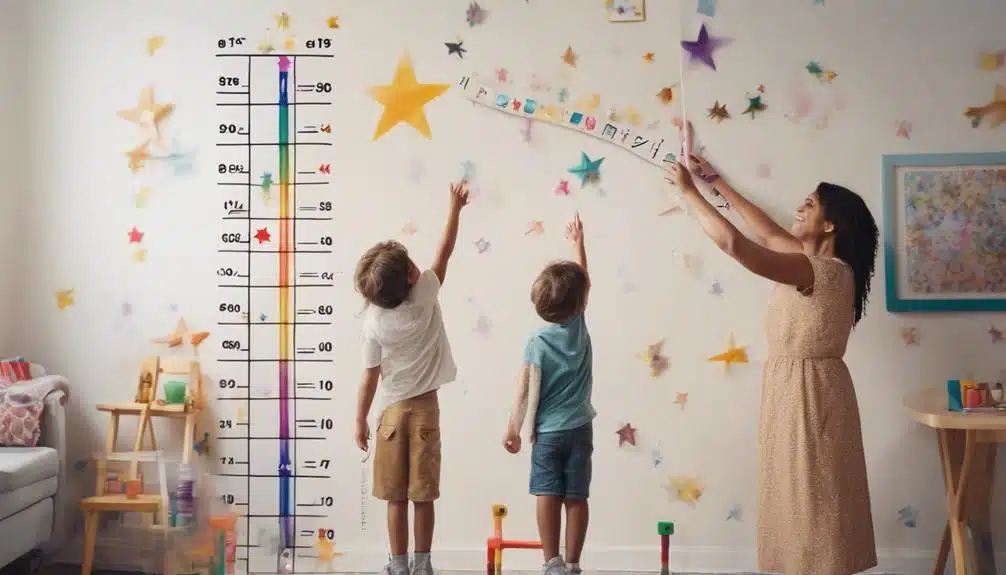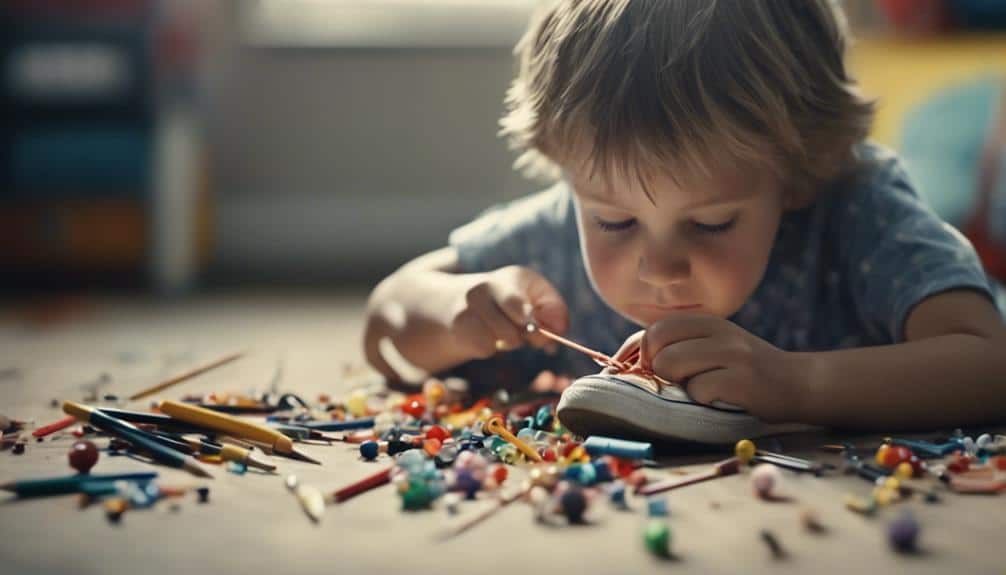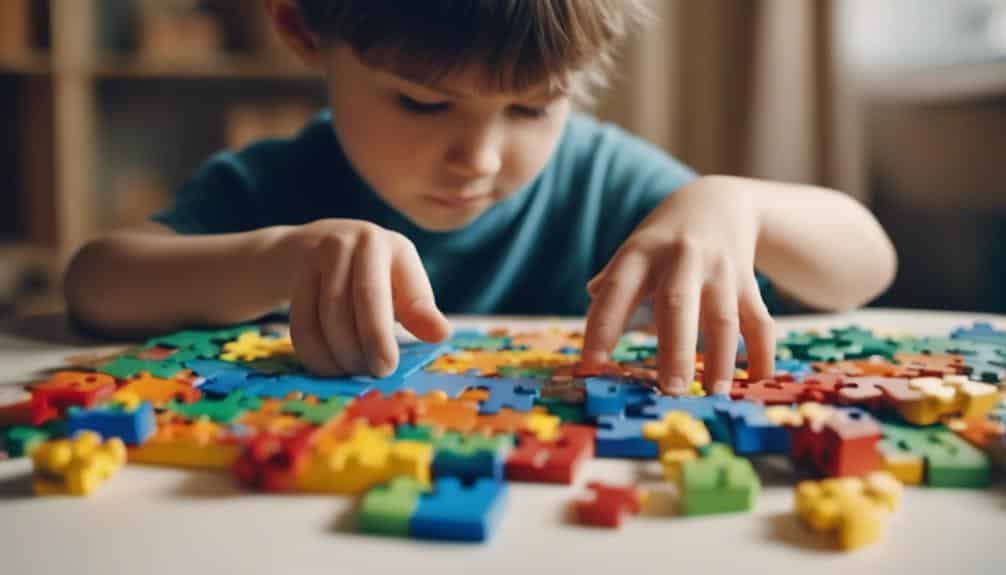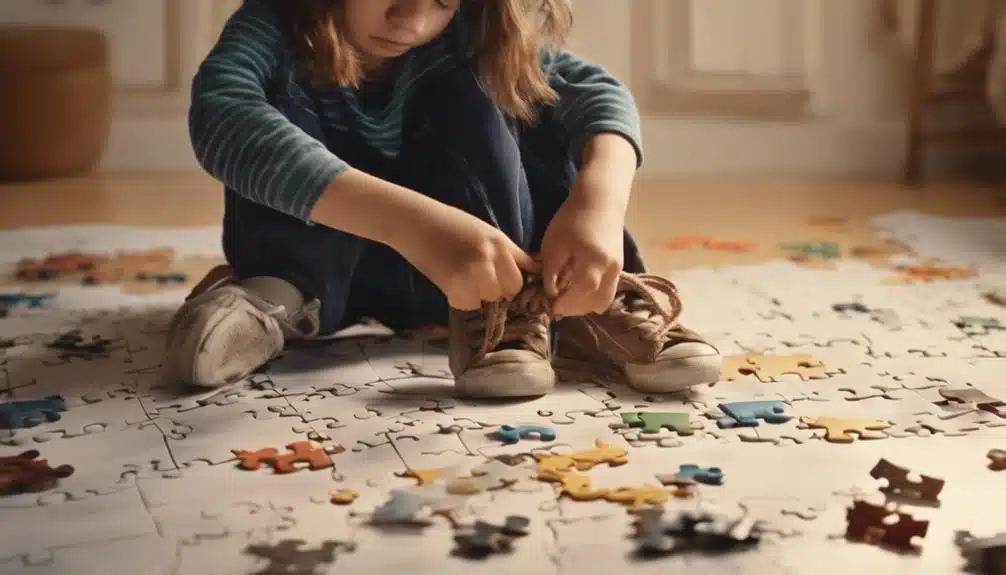Occupational therapy for children plays a pivotal role in addressing a spectrum of developmental, sensory, and motor skill challenges. Despite its significance, the reasons for children’s occupational therapy are frequently underestimated. This tailored approach extends beyond physical improvement, striving for comprehensive development to successfully empower children to navigate daily activities and social interactions.
Delving into the specific triggers that necessitate this therapy and examining how professionals discern the most effective interventions shed light on the transformative potential of occupational therapy in shaping a child’s trajectory. Consequently, exploring these aspects elevates the importance and intrigue of pediatric occupational therapy.
Key Takeaways
- Occupational therapy helps children with developmental delays reach their full potential.
- It addresses fine motor skills, sensory processing, and social interaction challenges.
- Therapy is tailored for children facing difficulties in learning, focusing, and emotional regulation.
- Involves family in therapy to support the child’s development and improve self-esteem.
Purpose of Pediatric OT
Pediatric occupational therapy consistently aims to empower children to achieve their maximum potential by engaging them and their families in a comprehensive, supportive process. This specialized treatment focuses on assisting children in overcoming obstacles that impede their everyday functions, such as difficulties with motor skills, sensory processing, and self-care tasks. Pediatric occupational therapists foster growth and development by providing a nurturing environment that values each child’s unique needs.
Through a tailored approach, they help children enhance their self-esteem and sense of accomplishment, ensuring they can participate fully in their daily activities. This empathetic and patient-centered methodology underscores the commitment to enabling children to navigate their world more effectively, promoting a sense of belonging and success in their endeavors.
Importance of Family Involvement
Active participation by families in the occupational therapy process is crucial for maximizing the therapeutic outcomes for children. Engaging family members in therapy sessions fosters a deeper understanding of the child’s needs and equips them with the necessary tools and strategies to support their child’s development at home. This collaborative approach ensures that therapy extends beyond the clinical setting, creating a consistent and nurturing environment for the child’s growth.
Family involvement is essential in setting realistic goals, understanding the child’s progress, and celebrating their achievements together. By working closely with occupational therapists, families become integral partners in empowering their children to reach their full potential, reinforcing that they are not alone in this endeavor.
Boosting Child Self-Esteem
 Boosting a child’s self-esteem is a crucial aspect of pediatric occupational therapy, aiming to empower children to feel more confident and capable in their daily activities. By focusing on their strengths and gradually overcoming challenges, occupational therapy is pivotal in enhancing a child’s self-perception and belief in their abilities. This process involves:
Boosting a child’s self-esteem is a crucial aspect of pediatric occupational therapy, aiming to empower children to feel more confident and capable in their daily activities. By focusing on their strengths and gradually overcoming challenges, occupational therapy is pivotal in enhancing a child’s self-perception and belief in their abilities. This process involves:
- They identify activities the child enjoys and excels in that foster a sense of achievement.
- It is setting achievable goals to provide a structured path for success and progress.
- We are celebrating small victories, reinforcing positive behavior and effort.
- We provide consistent support and encouragement, emphasizing the child’s value and capabilities.
Through these steps, occupational therapy nurtures a positive self-image, helping children see themselves as competent, resilient individuals and fostering a sense of belonging and acceptance.
Developmental Milestones Evaluation
Evaluating developmental milestones is a foundational element of pediatric occupational therapy, ensuring children progress appropriately in their physical, cognitive, and emotional development. This critical assessment helps identify areas where a child may be experiencing delays or challenges, guiding the therapeutic approach to support their unique needs. Occupational therapists approach this evaluation with empathy, understanding that each child’s journey is distinct.
They provide a patient and knowledgeable assessment that respects the child’s pace, encouraging families to see the value in every small step forward. This process fosters a sense of belonging and community among families navigating similar challenges, reinforcing the message that they are not alone in their journey toward developmental progress.
Steps for Developmental Progress

Identifying and implementing steps for developmental progress is essential in guiding children toward achieving their full potential in a supportive and understanding manner. The journey of each child is unique, but there are foundational steps that can foster growth and development.
- Personalized Assessment: Begin with a thorough evaluation to understand the child’s needs and strengths.
- Goal Setting: Collaboratively establish clear, achievable goals with the child and their family, focusing on meaningful outcomes.
- Tailored Interventions: Design engaging interventions based on the child’s interests to promote independence.
- Continuous Support and Evaluation: Offer ongoing encouragement, adjust strategies as needed, and celebrate every progress, no matter how small.
This approach ensures a sense of belonging and builds confidence in children as they navigate their developmental journey.
Motor Development Issues
Building on the foundation of personalized assessments and targeted interventions, addressing motor development issues becomes crucial in supporting children’s journey toward functional independence and well-being. Children facing challenges with gross or fine motor skills may struggle with everyday activities often taken for granted. Occupational therapy offers a compassionate bridge to mastering these essential skills.
| Challenge | Therapeutic Intervention | Goal |
|---|---|---|
| Poor Grip Strength | Customized Hand Exercises | Enhanced Fine Motor Skills |
| Difficulty Walking | Balance and Coordination Games | Improved Gross Motor Skills |
| Clumsiness | Sensory Integration Activities | Better Body Awareness |
| Delayed Milestones | Targeted Developmental Play | Achieving Age-Appropriate Tasks |
| Coordination Issues | Motor Planning Strategies | Smooth, Coordinated Movements |
Sensory Sensitivity Support

Children with sensory sensitivity often require tailored occupational therapy interventions to navigate their world more comfortably. These children may experience overwhelming responses to sensory stimuli in their environment, such as loud noises or certain textures, making everyday situations challenging. Occupational therapy offers a compassionate and understanding approach to help these children adapt more effectively.
- Creating Sensory Diets: Custom routines incorporating specific sensory activities to help regulate the child’s sensory system.
- Environmental Modifications: Adjusting the child’s surroundings reduces sensory overload and enhances comfort.
- Sensory Integration Techniques: Activities designed to help the child process sensory information more effectively.
- Therapeutic Use of Play: Engaging the child in activities that subtly address sensory sensitivities, promoting learning and adaptation.
Through these interventions, occupational therapy nurtures a sense of belonging, ensuring that children with sensory sensitivities can participate more fully in their daily lives.
Addressing Developmental Delays
Addressing developmental delays in children is a crucial aspect of pediatric occupational therapy, aimed at supporting their journey towards achieving key milestones. This specialized treatment is not just about interventions; it’s about understanding each child’s unique pace and offering a nurturing environment that fosters growth. Pediatric occupational therapists bring knowledge, patience, and empathy to assess and guide children through their developmental challenges.
They work closely with families, ensuring they are integral to the process, creating a sense of belonging and support. By focusing on the child’s needs, occupational therapy helps build a solid foundation for learning, interaction, and essential life skills, ensuring every child can thrive uniquely.
Fine Motor Skills Challenges

Following the exploration of developmental delays, it is crucial to highlight the significance of overcoming fine motor skills challenges, which play a vital role in a child’s ability to perform daily tasks and engage in learning activities. Fine motor skills encompass the tiny movements made with the fingers, hands, and wrists. Children facing difficulties in this area may struggle with:
- I am writing and drawing neatly.
- I am fastening clothing items like buttons and zippers.
- I am using utensils properly during mealtime.
- I am participating in play that requires precise hand-eye coordination.
Occupational therapy offers a compassionate and tailored approach to help children improve these skills, enhancing their independence and confidence in everyday activities. We foster a sense of belonging and achievement by addressing fine motor skills challenges and empowering children to navigate their world more effectively.
Sensory Processing Assistance
Sensory processing assistance through occupational therapy provides vital support for children who experience overwhelming responses to everyday sensory stimuli. This specialized care helps children navigate their world more comfortably, fostering a sense of belonging and acceptance in environments that might otherwise feel threatening or alien. Occupational therapists work patiently and empathetically, using their deep understanding of sensory processing to tailor interventions that make a meaningful difference in the lives of these children and their families.
| Intervention | Benefit |
|---|---|
| Sensory Diets | Customized activities that promote appropriate responses to sensory input, enhancing focus and calm. |
| Environmental Modifications | I am adjusting spaces to reduce sensory overload, creating a safe and supportive environment. |
| Tactile Integration | Activities that help children tolerate different textures, reducing sensitivity or avoidance. |
| Therapeutic Listening | Uses sound therapy to improve attention, balance, and sensory regulation. |
Through these interventions, occupational therapy offers a pathway to improved well-being and social integration for children with sensory processing challenges.
Learning and Skill Delays

Based on the foundation of sensory processing assistance, occupational therapy supports children with learning and skill delays. These delays can profoundly impact a child’s educational journey and self-esteem. Occupational therapy intervenes with targeted strategies to bridge these gaps, fostering a sense of belonging and achievement. Here are key areas where occupational therapy can make a difference:
- We are enhancing fine motor skills for writing, cutting, and other school-related tasks.
- We are developing organizational and time management skills for better learning outcomes.
- We are implementing strategies to improve focus and attention in classroom settings.
- We are addressing challenges in following instructions and completing tasks independently.
With patience and expertise, occupational therapists work alongside families, ensuring that each child can navigate their learning environment with confidence and success.
Challenges in Social Interaction
Occupational therapy offers vital support for children who struggle with social interaction, addressing the complex challenges they face in connecting with peers and navigating social environments. These children may find it challenging to interpret social cues, engage in cooperative play, or express their emotions appropriately. Such challenges can lead to isolation and frustration, impacting their self-esteem and sense of belonging.
Through a compassionate and patient approach, occupational therapists work to develop these children’s social skills, teaching them how to interact effectively with others. They employ strategies tailored to each child’s unique needs, facilitating improved communication and a deeper understanding of social norms. This support enhances their ability to participate in meaningful relationships and nurtures a positive self-image and a sense of community.
Learning Focus and Impulse Control

Children facing learning focus and impulse control challenges can significantly benefit from targeted occupational therapy interventions to enhance their cognitive and behavioral skills. Occupational Therapy (OT) provides a nurturing environment where children can develop the necessary skills for academic and social success. Here are ways OT can support these children:
- Building Concentration: Through engaging activities, OT helps children increase their attention span.
- Enhancing Self-Regulation: Children learn strategies to manage their impulses, contributing to better classroom behavior and social interactions.
- Improving Organizational Skills: OT assists in developing systems that help children organize their tasks and time efficiently.
- Supporting Emotional Development: By addressing impulse control, OT aids in emotional maturity, enabling children to feel more secure and connected in their environments.
This approach fosters a sense of belonging and achievement among children, paving the way for a more confident and independent future.
Therapy Types and Interventions
Understanding the various therapy types and interventions is crucial for addressing each child’s unique challenges in pediatric occupational therapy. Each child’s journey is distinct, so occupational therapy adopts a multifaceted approach tailored to individual needs. Therapists may employ sensory integration techniques to help children with sensory processing difficulties or fine motor skill exercises for those struggling with tasks like writing or using utensils.
Play-based therapy is often utilized to engage children in a manner that fosters development while ensuring the experience is enjoyable and stress-free. For children facing challenges in social interaction, social skills training can be integral to their therapy. By meticulously selecting the appropriate interventions, occupational therapists empower children to overcome obstacles, fostering a sense of accomplishment and belonging.
Communicating About Therapy

How do we effectively communicate the importance and process of occupational therapy to children reassuringly and understandably? Ensuring a child feels safe and valued while explaining the journey ahead is crucial. Here’s how:
- Use Simple Language: Break down complex therapy terms into more straightforward concepts that a child can grasp.
- Incorporate Visual Aids: Pictures and stories can help illustrate what to expect during therapy sessions.
- Please focus on the Positive: Emphasize how therapy will help them achieve currently challenging tasks.
- Involve Them in the Process: Ask for their input and make them feel like an active participant in their journey to improvement.
This approach fosters a sense of belonging and empowerment, making the therapeutic journey a shared adventure.
Frequently Asked Questions
What are the reasons for children’s occupational therapy?
Children’s occupational therapy serves multiple purposes, encompassing various therapeutic approaches. It addresses the unique needs of children through interventions such as autism therapy, fine motor skills development, ADD/ADHD therapy, social skills training, and academic improvement. These therapies aim to enhance overall well-being by addressing specific developmental challenges and fostering holistic growth in children.
What is DIRFloortime, and how does it benefit children in pediatric occupational therapy?
DIRFloortime, short for Developmental Individual Differences and Relationship-based Model, is an approach used in pediatric occupational therapy. It fosters emotional and cognitive development by engaging children in activities that build social and emotional skills through play and interaction.
Can Pediatric Occupational Therapy Be Integrated With a Child’s Existing Educational or Behavioral Therapy Plans, and How Is This Coordination Managed?
Pediatric occupational therapy can seamlessly blend with educational or behavioral plans, ensuring all hands are on deck. This coordination is managed through collaborative efforts among professionals, tailoring interventions to meet the child’s unique needs.
What Are the Qualifications and Training Requirements for Pediatric Occupational Therapists, and How Can Parents Verify the Credentials of a Potential Therapist?
Pediatric occupational therapists require specialized training, typically a master’s or doctoral degree in occupational therapy, and must pass a national certification exam. Parents can verify credentials through state licensing boards or professional occupational therapy associations.
How Do Cultural and Linguistic Differences Between the Child/Family and the Therapist Impact the Therapy Process, and What Measures Are Taken to Address These Differences?
Cultural and linguistic differences can impact therapy effectiveness, necessitating therapists to adopt inclusive practices, utilize interpreters and culturally relevant materials, ensuring a respectful, empathetic approach that fosters a sense of belonging and optimizes therapeutic outcomes.
What are the latest Advances or technologies in pediatric occupational therapy to enhance treatment outcomes?
Recent advancements in pediatric occupational therapy include virtual reality for immersive skill development, sensorimotor equipment for enhanced feedback, and applications designed for acceptable motor skill improvement, all aimed at facilitating more effective and engaging treatment outcomes.
Conclusion
Pediatric occupational therapy is a type of therapy that helps children with physical and developmental disabilities enhance their functioning skills and improve their quality of life. This therapy focuses on developing essential motor, sensory, and self-help skills that children need to perform daily tasks, such as feeding, dressing, and other everyday activities. It also helps children with sensory processing issues, motor challenges, and behavior disorders learn how to manage their arousal levels and social norms to function better in the school environment.
During occupational therapy sessions, therapists use various tools and activities to help children develop age-appropriate skills, such as finger painting to improve finger strength and eye contact, obstacle courses to improve motor coordination, and therapy balls to improve sensory skills. They also work collaboratively with other therapists, such as physical and speech therapists, to address other issues, such as spinal cord injuries, cerebral palsy, and brain injuries.
Occupational therapy aims to help children with disabilities develop various skills to help them with their academic and everyday life tasks. It also allows children to adapt to their environments by providing them with assistive devices and environmental adaptations. By providing a collaborative approach to therapy, occupational therapy helps children reach their developmental milestones and improve their overall well-being. To navigate the world around them. To navigate the world around them.


Recent Comments